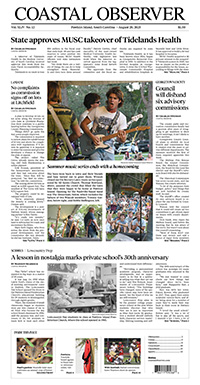Environment
Engineers outline plan for dredging port’s inner harbor

A recently released study of Georgetown’s port recommends dredging part of the inner harbor to support existing commercial and recreational needs.
The project to deepen the harbor’s two channels is estimated to cost around $4.4 million. It is a different project that the one Georgetown County proposed for a capital projects sales tax in 2014. That would have dredged a channel from Winyah Bay to the ocean. The $66 million price tag sank those plans.
The current project involves the Sampit River along the city’s waterfront, but stops short of Winyah Bay.
Tom Hutto, principal at GEL Engineering, presented his firm’s report at a public meeting in Georgetown this week.
The study recommended that county and city officials apply for a federal permit now for dredging that would start in the fall of 2024, and investigate what would be needed to close the Goat Island Cut, which is a shortcut that allows boaters to go between the Sampit River and Winyah Bay without following the river’s historic course past the steel mill and the Harborwalk. The creation of the shortcut disconnected the island from the mainland.
Hutto said closing the shortcut would reduce the need for dredging, but have “unintended consequences.” It could also not be done without permission from the federal government, he added.
According to GEL’s study, partially closing the shortcut would reduce sediment in the inner harbor by 55 percent. Completely closing it would reduce sediment by 85 percent.
Hutto said a wall could potentially be installed, which would have to go all the way down into the limestone in order to hold up under the water pressure.
“If you don’t think that water is going to have a lot of pressure, you’ve got another think coming,” he added. “It’s going to take a heck of a lot of engineering.”
Since the Corps of Engineers created the shortcut, Hutto believes the agency could close it, too.
“The Corps of Engineers likes nothing better than to fix things that they’ve done in the past,” Hutto said. “It’s done well and served the community well, but, at this point, it may be time for them to come back and take another look at that.”
After his presentation, Hutto was asked whether closing the shortcut would wash out the seawalls along the waterfront.
“We would have to have a structural engineer look at each seawall and evaluate it. A dredge is not going to go next to a seawall because you wouldn’t want to cause it to collapse. You would undermine it,” Hutto said. “I’m not signing off on any seawalls without a big study. It could cause a problem. … You wouldn’t want to close the cut and not do that evaluation.”
The study also recommends not proceeding with closing the shortcut until the long-term needs of Sampit River use are well-defined.
Hutto was also asked about the effects of dredging on the steel mill, the effects of of dredging on climate change, whether there are hazardous chemicals in the sediment to be dredged and how hurricanes would affect a deeper port.
GEL’s work is the second phase of a study commissioned by the city and county in 2018 and conducted initially by Coastal Carolina University.
Local officials were looking for a more sustainable and affordable solution than repeated dredging.
Among CCU’s solutions were deflection walls, restoring the harbor to its natural state and methods that would also assist in flood protection.
GEL started working on the engineering aspect of the study in 2020.




